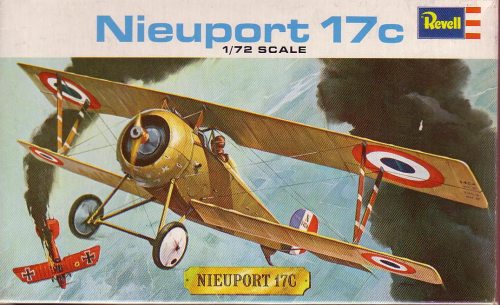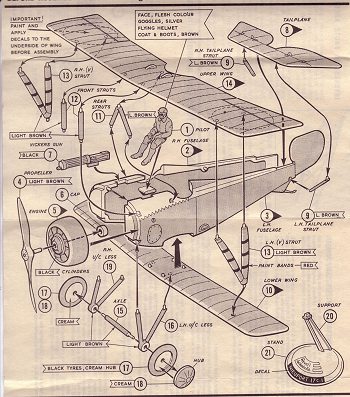
|
KIT: |
Revell 1/72 Nieuport 17c |
|
KIT # |
H-631 |
|
PRICE: |
$8-$15 these days |
|
DECALS: |
One to Three planes depending on boxing |
|
REVIEWER: |
|
|
NOTES: |
1963 kit, no cockpit detail. |

|
HISTORY |
The Nieuport 17 was introduced in March of 1916, as a replacement for the aging Nieuport 11 and 16 models then in service. It’s larger engine and synchronized Vickers machine gun enabled it to be more than a match for German fighters in service at the time. A number of French aces made their mark flying the Nieuport 17.
In addition to France, the Nieuport was also used by the British, Italians, Belgians, and Russians, Serbs, and Estonians, among others. There are a number of decal sheets available from aftermarket suppliers for a variety of Nieuports.
Nieuports were delivered from the factory with an overall dull silver doped finish. This was used because it was found that unpainted aircraft suffered from deterioration of the fabric from UV rays, and the silver dope was best at blocking the UV. Many Nieuports were left this silver color, with simple markings, but others had vivid personal markings, and others still were camouflaged. A little research will turn up a huge variety of choices.
|
THE KIT |
This kit was available in the late 1960s and into the 1970s, I believe. I’ve owned and built a few of them over the years, and have never seen any boxings of the kit from the 1980s or later. The model was also available in an “Aces” set of three aircraft, with the Albatross and DH-2.
The kit used for this preview is the UK version, although
it was released in the USA in basically the same way. This model includes
markings for only one aircraft, a camouflaged French aircraft. . This one is
a little unique in that it is molded in a medium brown plastic , instead of the
usual dark green.
, instead of the
usual dark green.
Revell also released this kit in the USA, in their “Collector’s Choice” series. Like the other aircraft in the series, that version of the N17 included decals to build one of three different versions.
My model is molded in dark green plastic, which is a little unusual (it also made it nearly impossible to photograph, hence the instruction sheet). You usually see this kit molded in silver or a light tan. The copy of the kit I’m using for this preview has almost no flash, and there are no signs of mold mis-alignment. Trailing edges seem to be pretty fine, too. The wings and fuselage suffer from somewhat overdone fabric detail, as was typical for kits from this era. You might want to consider a gentle sanding or just paint the model by brush to subdue the fabric effect, if it is overdone for your taste. The model has some sink marks on the parts that will need to be filled—for example the underside of the top wing has three big ones.
The fuselage has the same sort of engraved fabric detail. The rudder is molded as part of the left fuselage, and has vertical lines molded to show where the 3 colors on the tail are separated. This is a little odd, as you don’t paint the rudder—there is a tri-color decal.
As is typical in Revell’s WW1 kits from this era, the engine is molded as part of the cowl.
There is a pilot figure included in the kit. Detail is not very crisp, but he’s better than the fellow piloting the Sopwith Triplane! There is no interior detail at all—the pilot is glued to a little shelf.
My version included a display stand, but this is the only version I’ve owned that had it. (Maybe it is unique to the UK version—it does remind me of Airfix stands from the period.)
The decals you find in any of the kits from this series are unlikely to be of much use. The ones in my kit aren’t printed all that sharp, and the blue is a little on the dark side. If you’re going to build one of these, I’d just plan on getting a new decal sheet.
|
CONCLUSIONS |
Recommended. This is one of only two N.17s that I know if in 1/72—the other is the OOP Esci kit. They are very similar kits. The Esci was in production more recently, and may be easier to find.
This kit is a typical kit from the era—if you compare it to one of the Toko/Roden Nieuport 11 or 16 kits, you’ll be disappointed. (So don’t!)
Review kit courtesy of me and my wallet.
|
REFERENCES |
Nieuport Aces of World War One by Norman Franks. Osprey Aircraft of the Aces series, Osprey Publishing, 2000.
If you would like your product reviewed fairly and quickly by a site that has well over 175,000 visitors a month, please contact me or see other details in the Note to Contributors.